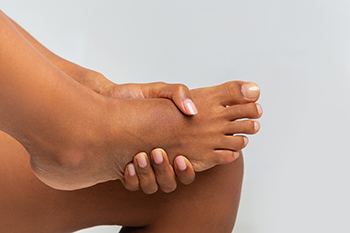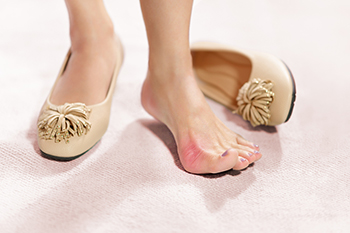Connect With Us
Blog
Items filtered by date: December 2022
Reasons Plantar Fasciitis Can Occur

Patients who have the foot condition known as plantar fasciitis generally cannot ignore the pain that accompanies it. This condition happens when the plantar fascia becomes inflamed, and the heel and calf are affected. The plantar fascia is the band of tissue that connects the heel to the toes and is found on the sole of the foot. Plantar fasciitis develops when the plantar fascia becomes inflamed, and this can happen for various reasons. Standing on hard surfaces for most of the day can contribute to getting plantar fasciitis, in addition to wearing shoes that do not fit correctly. Plantar fasciitis may hinder the ability to accomplish daily tasks and may worsen if prompt medical treatment is not received. Mild relief may be found when specific heel stretches are frequently performed. This is done by standing on a step while lowering one heel at a time until a gentle stretch is felt. If you are afflicted with plantar fasciitis, it is strongly advised that you are under the care of a podiatrist who can offer you the correct treatment options.
Plantar fasciitis can be very painful and inconvenient. If you are experiencing heel pain or symptoms of plantar fasciitis, contact one of our podiatrists from Crosstown Podiatry. Our doctors can provide the care you need to keep you pain-free and on your feet.
What Is Plantar Fasciitis?
Plantar fasciitis is the inflammation of the thick band of tissue that runs along the bottom of your foot, known as the plantar fascia, and causes mild to severe heel pain.
What Causes Plantar Fasciitis?
- Excessive running
- Non-supportive shoes
- Overpronation
- Repeated stretching and tearing of the plantar fascia
How Can It Be Treated?
- Conservative measures – anti-inflammatories, ice packs, stretching exercises, physical therapy, orthotic devices
- Shockwave therapy – sound waves are sent to the affected area to facilitate healing and are usually used for chronic cases of plantar fasciitis
- Surgery – usually only used as a last resort when all else fails. The plantar fascia can be surgically detached from the heel
While very treatable, plantar fasciitis is definitely not something that should be ignored. Especially in severe cases, speaking to your doctor right away is highly recommended to avoid complications and severe heel pain. Your podiatrist can work with you to provide the appropriate treatment options tailored to your condition.
If you have any questions please feel free to contact our offices located in Wayne, Montclair, and Randolph, NJ . We offer the newest diagnostic and treatment technologies for all your foot and ankle needs.
Medical Conditions That May Lead To Tarsal Tunnel Syndrome

The nerve that is located inside the tarsal tunnel is called the posterior tibial nerve. The tarsal tunnel is a narrow passageway that is found inside the ankle. It is held in place by soft tissue and bone, and this nerve can become compressed and irritated due to consistent pressure. It can also happen from medical conditions such as flat feet, diabetes, or arthritis which may cause this nerve to become irritated and inflamed. This is referred to as tarsal tunnel syndrome. Patients may experience a numbing or burning sensation and there may be shooting pain on the inside of the ankle. In severe cases, the pain may radiate to the heel, arch, and toes. Mild relief may be found when the affected foot is frequently rested and specific stretches are performed. These can include standing on the toes while using a chair for support and lifting the heels off of the floor. This is most effective when several sets are completed with a short rest period in between. If you think you may have tarsal tunnel syndrome, it is strongly urged that you are under the care of a podiatrist who can accurately diagnose and treat this condition.
Tarsal tunnel syndrome can be very uncomfortable to live with. If you are experiencing tarsal tunnel syndrome, contact one of our podiatrists of Crosstown Podiatry. Our doctors can provide the care you need to keep you pain-free and on your feet.
Tarsal Tunnel Syndrome
Tarsal tunnel syndrome, which can also be called tibial nerve dysfunction, is an uncommon condition of misfiring peripheral nerves in the foot. The tibial nerve is the peripheral nerve in the leg responsible for sensation and movement of the foot and calf muscles. In tarsal tunnel syndrome, the tibial nerve is damaged, causing problems with movement and feeling in the foot of the affected leg.
Common Cause of Tarsal Tunnel Syndrome
- Involves pressure or an injury, direct pressure on the tibial nerve for an extended period of time, sometimes caused by other body structures close by or near the knee.
- Diseases that damage nerves, including diabetes, may cause tarsal tunnel syndrome.
- At times, tarsal tunnel syndrome can appear without an obvious cause in some cases.
The Effects of Tarsal Tunnel Syndrome
- Different sensations, an afflicted person may experience pain, tingling, burning or other unusual sensations in the foot of the affected leg.
- The foot muscles, toes and ankle become weaker, and curling your toes or flexing your foot can become difficult.
- If condition worsens, infections and ulcers may develop on the foot that is experiencing the syndrome.
A physical exam of the leg can help identify the presence of tarsal tunnel syndrome. Medical tests, such as a nerve biopsy, are also used to diagnose the condition. Patients may receive physical therapy and prescriptive medication. In extreme cases, some may require surgery.
If you have any questions please feel free to contact our offices located in Wayne, Montclair, and Randolph, NJ . We offer the newest diagnostic and treatment technologies for all your foot and ankle needs.
Wearing High Heels May Cause a Bunion to Develop

A bunion can be unsightly. It is a bony protrusion that forms on the side of the big toe, and a severe bunion can cause the other toes to shift toward each other. It is a common foot deformity and affects women more than men. A callus may form on top of the bunion as it touches the shoe, and larger shoes may need to be purchased for a better fit. A bunion generally develops gradually, and it may form because of the shoes that are worn. Wearing high heels frequently can cause a bunion to grow and this may be due to the limited amount of room in the toe box. Medical conditions such as arthritis and flat feet may contribute to the development of a bunion. Some patients may be more at risk from genetic factors. Some of the symptoms that are often associated with bunions can include chronic toe pain, redness, and the bump may be shiny. Relief may be found when the symptoms are managed, the shoes are changed, or custom-made orthotics are worn. If you have a bunion, it is strongly urged that you consult with a podiatrist who can offer treatment options which may include surgery for permanent removal.
If you are suffering from bunion pain, contact one of our podiatrists of Crosstown Podiatry. Our doctors can provide the care you need to keep you pain-free and on your feet.
What Is a Bunion?
Bunions are painful bony bumps that usually develop on the inside of the foot at the joint of the big toe. As the deformity increases over time, it may become painful to walk and wear shoes. Women are more likely to exacerbate existing bunions since they often wear tight, narrow shoes that shift their toes together. Bunion pain can be relieved by wearing wider shoes with enough room for the toes.
Causes
- Genetics – some people inherit feet that are more prone to bunion development
- Inflammatory Conditions - rheumatoid arthritis and polio may cause bunion development
Symptoms
- Redness and inflammation
- Pain and tenderness
- Callus or corns on the bump
- Restricted motion in the big toe
In order to diagnose your bunion, your podiatrist may ask about your medical history, symptoms, and general health. Your doctor might also order an x-ray to take a closer look at your feet. Nonsurgical treatment options include orthotics, padding, icing, changes in footwear, and medication. If nonsurgical treatments don’t alleviate your bunion pain, surgery may be necessary.
If you have any questions, please feel free to contact our offices located in Wayne, Montclair, and Randolph, NJ . We offer the newest diagnostic and treatment technologies for all your foot care needs.
Avoiding Injuries During Sports

Playing sports can be fun and help to keep your body fit, but these activities also may put you at risk of certain injuries. Many injuries incurred while playing a sport are unavoidable, but there are some things you can do to lower the chances of them happening. Stretching and warming up, for instance, is highly recommended before embarking on any strenuous exercise. It is also recommended by experts to listen to your body when it says it needs to rest, rather than pushing on through the pain or fatigue. This can help to avoid strains, sprains, stress fractures, or overuse injuries. Further, to help keep injuries at bay it is suggested to wear any necessary protective gear and footwear specifically designed for that sport. Keeping hydrated before, during, and after sports activity is also desirable. Finally, if you get hurt while playing a sport, stop the activity immediately and rest. Injuries to the Achilles tendon, ankle joint, feet, and muscles will only become worse, and possibly chronic if ignored. It is wise to see a podiatrist if such an injury occurs for a proper diagnosis and treatment plan.
Ankle and foot injuries are common among athletes and in many sports. They can be caused by several problems and may be potentially serious. If you are feeling pain or think you were injured in a sporting event or when exercising, consult with one of our podiatrists from Crosstown Podiatry. Our doctors will assess your condition and provide you with quality foot and ankle treatment.
Common Injuries
The most common injuries that occur in sporting activities include:
- Achilles Tendonitis
- Achilles Tendon Rupture
- Ankle Sprains
- Broken Foot
- Plantar Fasciitis
- Stress Fractures
- Turf Toe
Symptoms
Symptoms vary depending upon the injury and in some cases, there may be no symptoms at all. However, in most cases, some form of symptom is experienced. Pain, aching, burning, bruising, tenderness, tightness or stiffness, sensation loss, difficulty moving, and swelling are the most common symptoms.
Treatment
Just as symptoms vary depending upon the injury, so do treatment options. A common treatment method is known as the RICE method. This method involves rest, applying ice, compression and elevating the afflicted foot or ankle. If the injury appears to be more serious, surgery might be required, such as arthroscopic or reconstructive surgery. Lastly, rehabilitation or therapy might be needed to gain full functionality in the afflicted area. Any discomfort experienced by an athlete must be evaluated by a licensed, reputable medical professional.
If you have any questions, please feel free to contact our offices located in Wayne, Montclair, and Randolph, NJ . We offer the newest diagnostic and treatment technologies for all your foot care needs.

